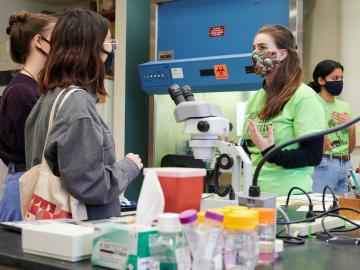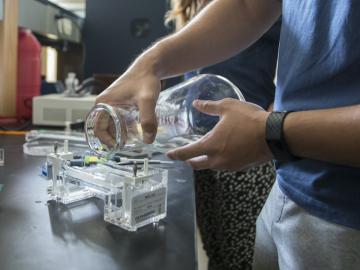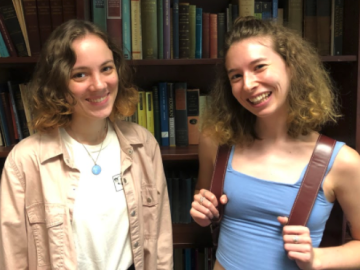Campus News
Senior Symposium 2017
April 27, 2017
Communications Staff
The Office of Undergraduate Research invites all members of the campus and community to celebrate the scholarly and artistic endeavors of members of the Class of 2017 at the eighth annual Senior Symposium on Friday, April 28.
More than 75 seniors and fifth-year students on 20 panels will each give a brief presentation about work they performed for honors, capstones, or research they conducted individually or with a faculty mentor. The afternoon symposium will examine a broad range of questions such as “Is the Music Industry Failing?” and “What's in a Neanderthal?”
The symposium takes place in the King Building. Concurrent panels begin at 1:30, 3:00, and 4:30 p.m. in various rooms on the third floor. There will be a reception from 5:50 p.m. - 6:15 p.m. in the third floor lounge, followed by a closing keynote address, titled “Whipped Cream, Whiskey, and Weight Loss: Exploring the Versatility of E-cigarette Use in Adolescents and Adults,” at 6:15 p.m. by Professor Meghan Morean and Alexa L’Insalata ‘17 in King 306.
Get a quick sampling of just three of the projects from Friday's presenting seniors:
Presenter: Grover Neville
The Sonification of Money: Applying Creative Innovation in the Music Industry
Is the music industry really failing? Mainstream and scholarly rhetoric is fierce on this topic, much of it centering around the Recording Industry Association of America’s annual music industry’s annual reports which show gross revenues halving every year since 1994. In this paper, I examine the current profitability and sustainability of the music industry and argue that there remains significant untapped commercial potential in the American music market. My analysis will use the IDEO design company and Creative Problem Solving Institute’s creative design process tools. With this framework of Human-centered design and creative problem solving, I identify and define the following goals of the music industry: distribution, artist sustainability, and audience relations. I also put each of these issues into context with case studies on RIAA economic figures, market constriction, and shifting technological mediums to propose three solutions to combat economic stagnation in these areas. These solutions, which include restructuring management models, leveraging podcasting, and matching media formats to markets, are inherently useful, but also serve as examples of creative problem-solving process applied to the music industry. My conclusion is that the industry requires a new approach to solving the economic struggles it is experiencing, and that creative design thinking can be a powerful tool in this process.
Presenter: Kirk Pearson
Experimental Biomechanics on Trinucleid Fringe Pits (Trilobita)
The morphometric uniqueness of the trinucleid family of fossil arthropods, known as the trilobites, has led to a considerable amount of attention in paleontology literature. In particular, the distinctive hourglass-shaped pits that dot their anterior have been the subject of debate for over a century. Though anatomically well understood, their function remains unknown. Many proposals have been suggested, including its use as a sieve for filter feeding, a strong shield for defense, and a sensory mechanism. Despite the wide ranges of speculations, no study has attempted to model these hypotheses with experimental methods. This study in functional morphology attempts to shed light on the validity of the most contentious of these theories by 3D printing a trinucleid head and testing its abilities in a variety of situations. We found that the dominant theories for over a century, filter feeding and strengthening, are not well supported. Instead, our results suggest that the pits are an ontogenetic signature that allow the cephalon to grow larger, providing trinucleids with an excellent mechanism for plowing through fine-grained silts and clays.
Presenter: Mattea Scheiber Koon (co-author, Olivia Hay)
Investigating Allomorphy in a Coordinating Conjunction: A Corpus Study of Hiaki (Yaqui) Into(k(o))
Hiaki (Yaqui) is an endangered Uto-Aztecan language spoken in Sonora, Mexico and Arizona, USA. In Hiaki, the coordinating conjunction ‘and’ appears in three iterations: into, intok, and intoko. The presence of such variation often suggests a form of allomorphy, with each morpheme appearing in a predictable environment as in the case of English ‘a’ and ‘an’ variation (the former consistently precedes consonant-initial words; the latter, vowel-initial words). A cursory look at into(k(o)) suggests that a similar process is at play here, with scholars offering a variety of interpretations for into(k(o)) variation. To determine the motivating factors underlying into(k(o)) distribution, we subjected a corpus of Hiaki data to a battery of tests. We examined phonological factors, syntactic constraints, and semantic patterns. Ultimately, this barrage of tests failed to yield a dependable motivation for into(k(o)) variation. This finding suggests thatinto(k(o)) is in free variation.
Tags:
You may also like…
Students Explore Oberlin’s Range of Research in This Year’s Lab Crawl
November 17, 2021
Lab Crawl was well attended this semester with many students making stops at demonstrations held in one or more of 22 labs across campus.
This Week in Photos: Alzheimer's Research
August 5, 2021
A picture of a student transferring an opaque substance into a gel box in a neuroscience lab serves as inspiration for this week’s photo series.
Emma Glen and Emily Hudson Publish Translations and Book Review
August 4, 2021
Third-years demonstrate artistry and command of language with translations of Latin poet Catullus.


